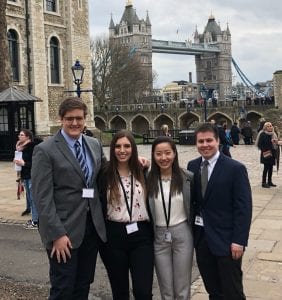Enhancing Access at the Tower of London
Executive Summary
The Tower of London is a 1000-year-old fortress, palace, and prison. The Tower was designed to be difficult to enter and harder to escape. Spiral staircases, uneven surfaces, and narrow doorways pose access challenges for D/deaf and disabled visitors at the Tower. In the United Kingdom 19% of people identify as disabled; however, only 59% of people rated museums and art galleries as ‘good’ for accessibility (Smith, 2017; Vocaleyes, 2016). The Tower of London would like to increase accessibility for disabled individuals but traditional methods of improving access can be difficult to implement due to the historic nature of the Tower. For this reason, Historic Royal Palaces would like to explore the possibility of implementing digital technologies to improve accessibility for disabled visitors at the Tower.
Our goal for this project was to evaluate how digital technologies can help HRP increase accessibility for D/deaf and disabled visitors at the Tower of London. To complete this goal, we identified five main objectives:
- Perform market research to assess digital technologies used to broaden access in the museum and heritage sectors and assess emerging technologies that could be applicable in the future.
- Assess the current state of accessibility at the Tower of London for the D/deaf and disabled communities.
- Assess stakeholder opinions in the D/deaf and disabled communities regarding the use of technology to promote greater accessibility.
- Evaluate the viability of implementation of current and potential technologies to promote greater access at the Tower of London.
- Recommend how HRP might improve accessibility at the Tower of London using digital technologies.
We began by researching digital technologies currently used for accessibility as well as technologies that could be used to increase access. We toured the Tower of London multiple times in search of access challenges. Additionally, we analyzed the Access Review of the Tower of London to isolate which challenges were most common as well as which ones we thought could be fixed with digital technologies. We also researched and visited the most accessible museums and historical sites in the United Kingdom to find out what technologies they use. We met with representatives from Hampton Court Palace, the British Museum, Graeae Theatre, and the Roald Dahl Museum and Story Center. These visits helped us narrow our list of potential digital technologies based on feedback the museums have received. Additionally, these organizations introduced us to some technologies of which we were unaware. With the help of Graeae Theatre, we developed a survey to understand the current state of access at the Tower as well as technology preferences among disabled people. Graeae was instrumental in our efforts to make the survey as accessible and sensitive as possible. After we completed these site visits, we conducted six accompanied tours with visitors with various disabilities. Each of these visits lasted approximately two hours and was followed by a short interview. We asked visitors to explain some of the access barriers they encountered on their visit and describe their overall impression of accessibility during their visit. We also asked what technologies they thought might have improved their visit. These accompanied tours were tremendously helpful to us in deciding the best digital technologies for implementation by allowing us to understand the access challenges present at the Tower.
Through our research we found that there is a diverse range of preferences on assistive technology. We used the results from our survey and accompanied tours to produce a number of recommended digital technologies to enhance access at the Tower. From our research, we found that 3D printed models, Signly, and Virtual Reality best address the current access needs at the Tower of London. Additionally, there are a few developing technologies that we suggest Historic Royal Palaces monitor moving forward. We also compiled a list of non-digital technologies to be used in conjunction with the suggested digital technologies to increase accessibility at the Tower.



